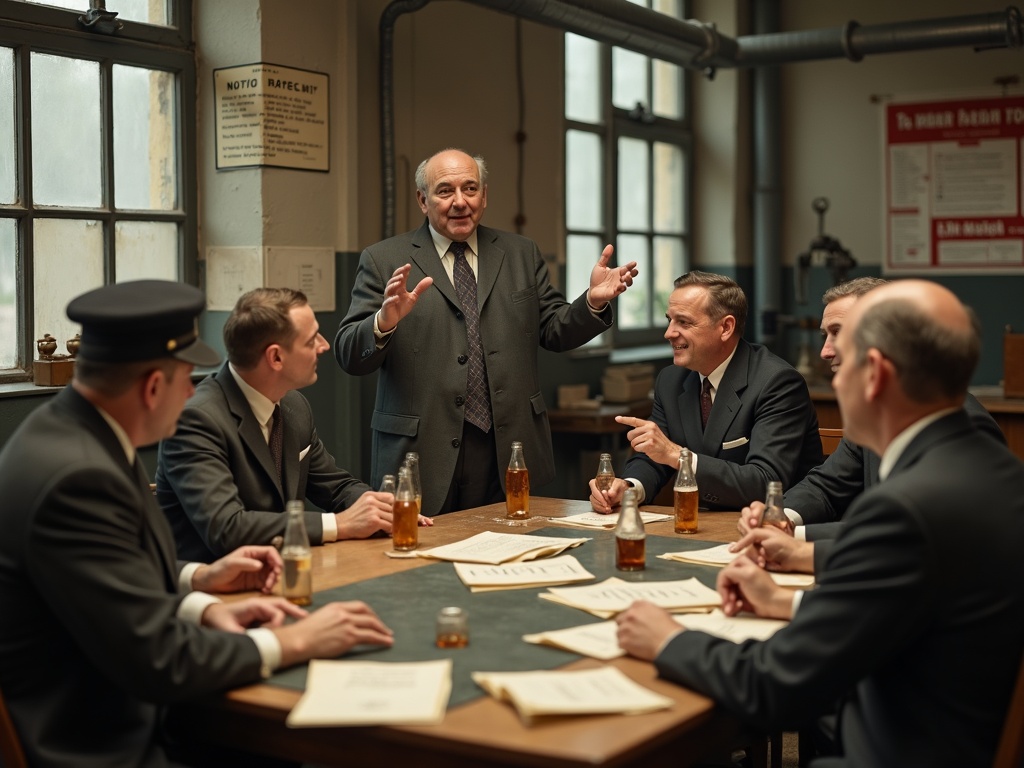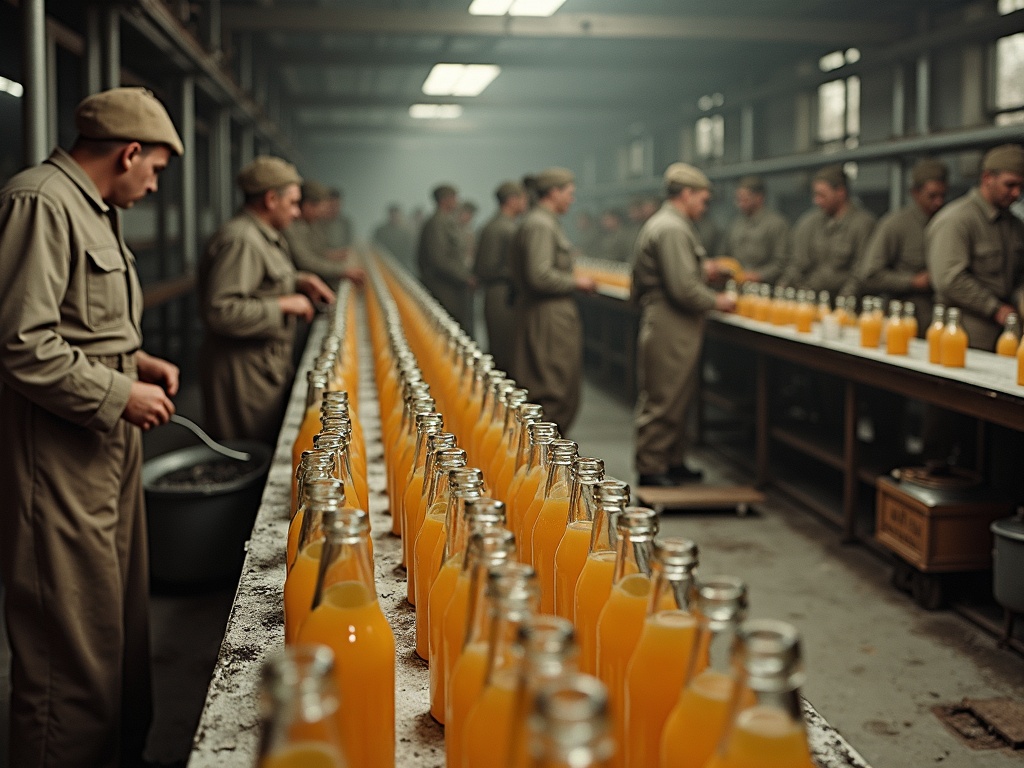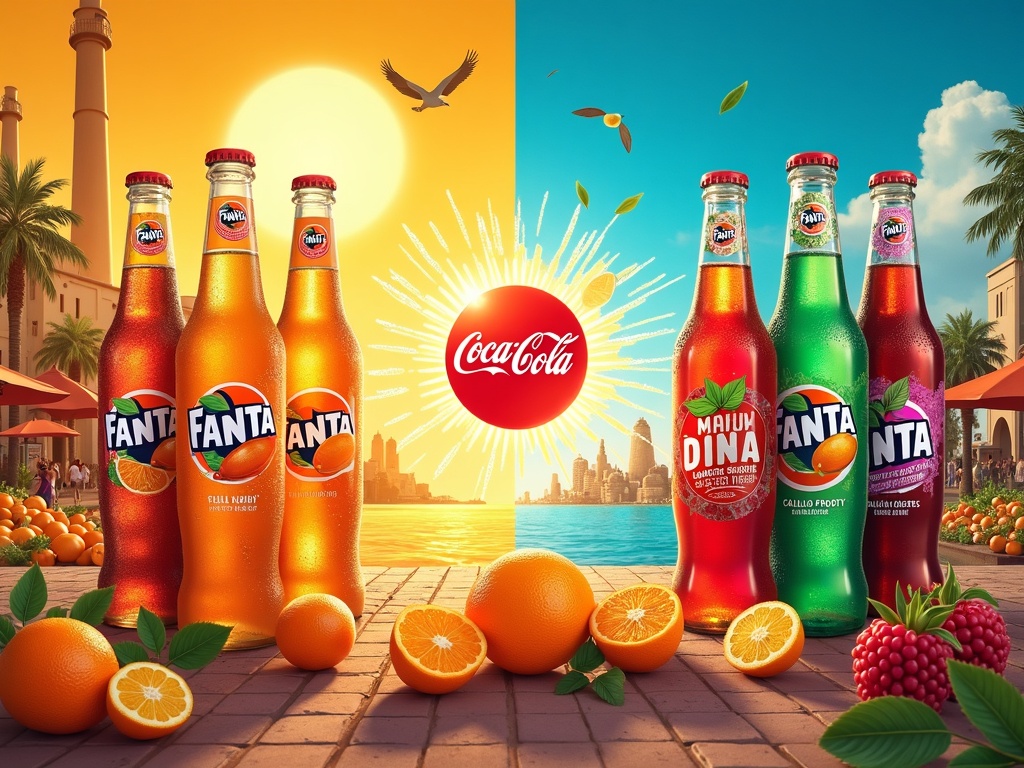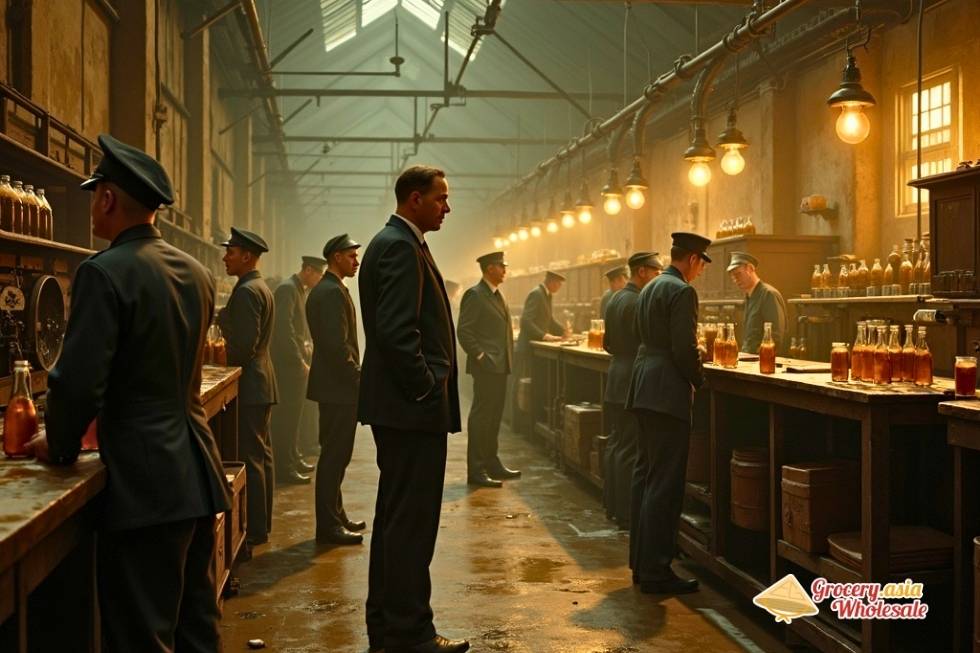No products in the cart.
Beverages News, Fanta Carbonated Soft Drinks, Soft Drinks
Who Made Fanta And The Sweet History Revealed
Fanta emerged in 1940 Nazi Germany as a wartime substitute when trade embargoes prevented Coca-Cola syrup imports, created by German businessman Max Keith using available ingredients like apple pomace and whey. After the war, Coca-Cola reclaimed the brand and relaunched it in 1955 Italy with a completely new citrus formula, transforming a desperate wartime creation into what became one of the world’s most successful soft drink brands available in over 190 countries.
Table of Contents
Key Takeaways
- Fanta was invented in 1940 by Max Keith during World War II as a substitute beverage when Nazi Germany couldn’t import Coca-Cola syrup due to trade embargoes.
- The original recipe used unconventional wartime ingredients including whey, apple pomace, and saccharin, creating a cloudy beige drink that Germans sometimes used as a cooking sweetener.
- The name “Fanta” originated from Joe Knipp shortening the German word “Fantasie” (imagination) during a brainstorming session led by Max Keith.
- Max Keith demonstrated remarkable integrity by refusing to join the Nazi party and later returning all Fanta profits to Coca-Cola USA after the war ended.
- Coca-Cola relaunched Fanta in 1955 Italy with a new citrus formula, transforming the wartime creation into a global brand now available in over 190 countries with more than 100 unique flavors.
The Dark Origin: Fanta’s Birth in Nazi Germany
I often find it shocking when people discover that Fanta has one of the most controversial origins in beverage history. Who invented Fanta isn’t just a simple corporate story – it’s tied directly to Nazi Germany and wartime survival tactics.
Fanta emerged in 1940 during World War II under circumstances that would make any modern marketing executive cringe. The U.S. had imposed strict trade embargoes on Nazi Germany, and the Trading with the Enemy Act effectively severed all communication and supply lines between Coca-Cola’s American headquarters and its German subsidiary, Coca-Cola GmbH.
This created an immediate crisis for the German operation. They couldn’t import the secret syrup concentrate needed to produce Coca-Cola, yet they still had factories to run and workers to pay. The German Coca-Cola team faced a stark choice: shut down operations entirely or find an alternative product to manufacture.
Creating Something from Nothing
The solution came through pure necessity and resourcefulness. The German team decided to create an entirely new beverage using whatever ingredients they could source locally during wartime rationing. They gathered:
- Apple fiber and pomace (leftover fruit pulp from cider production)
- Whey (a cheese-making byproduct)
- Whatever sugar substitutes they could obtain
- Local fruit flavoring agents
The resulting orange-flavored soda kept Coca-Cola GmbH operational throughout the war years. Where Fanta originated was specifically in Germany’s beverage factories, born from wartime scarcity rather than corporate innovation.
What’s particularly striking about this history is how a beverage created under such dark circumstances became one of the world’s most popular soft drinks. The German operation maintained its independence throughout the Nazi regime, producing millions of bottles of this makeshift soda while the rest of the world remained cut off from Coca-Cola’s German activities.
After the war ended, Coca-Cola reclaimed control of its German operations and eventually adopted Fanta as a global brand. The company reformulated the drink using better ingredients and expanded its reach worldwide, effectively washing away its wartime origins through marketing and widespread distribution.
This origin story raises important questions about corporate responsibility and historical accountability that continue to influence how we view major brands today.
Max Keith: The Businessman Who Saved Coca-Cola in Germany
Max Keith stands as one of the most remarkable figures in corporate history, a German businessman who managed Coca-Cola GmbH from 1933 and demonstrated extraordinary integrity during one of history’s darkest periods. When Nazi pressure mounted for him to join the party, Keith refused, choosing principle over political convenience. This decision would prove crucial not just for his personal legacy, but for the future of Coca-Cola in Europe.
Creating Fanta Under Impossible Circumstances
Keith faced an enormous challenge when World War II erupted and Coca-Cola syrup imports from America ceased. Rather than surrender his bottling plants to government control, he made a brilliant strategic decision. He invented Fanta as a replacement product, using available ingredients like fruit scraps and whey to create a beverage that could keep his operations running.
This wasn’t just business survival – it was corporate resistance. Keith understood that maintaining independent control of the bottling facilities meant preserving Coca-Cola’s future presence in Germany. The ingredients he used for Fanta were often creative substitutes born from wartime rationing, yet he managed to create a product that sustained the business through impossible circumstances.
Post-War Integrity That Defined His Legacy
Keith’s true character emerged after Germany’s defeat. In an unprecedented display of corporate loyalty, he returned all of Fanta’s profits and brand rights to Coca-Cola USA. This action earned him global recognition for integrity and demonstrated that his wartime decisions weren’t motivated by personal gain or political allegiance, but by genuine commitment to the company he served.
The Allied forces initially investigated Keith after the war, suspicious of any German businessman who had maintained operations during the Nazi regime. However, investigators soon discovered his principled stance and cleared his name completely. They recognized that Keith had actually protected American corporate interests while refusing to collaborate with the Nazi party.
Keith’s creation ultimately became one of the world’s most successful soft drink brands, though that wasn’t his intention during those difficult wartime years. His primary goal was preservation — keeping Coca-Cola’s German infrastructure intact for eventual American return.
Following his vindication, Coca-Cola rewarded Keith’s loyalty by appointing him to oversee the company’s European operations. This promotion reflected the company’s recognition that Keith had essentially saved their European presence through his quick thinking and unwavering principles. The origins of Fanta thus represent not just wartime innovation, but corporate heroism under extreme pressure.
Keith’s story illustrates how individual integrity can shape corporate history. His refusal to compromise his principles, combined with his innovative response to crisis, created lasting value for Coca-Cola while maintaining ethical standards during a morally compromised era. The businessman who could have easily capitalized on wartime chaos instead chose loyalty and honesty, transforming a survival strategy into a global success story.

From “Fantasie” to Fanta: The Story Behind the Name
I’ve always found the origin of brand names fascinating, and Fanta’s story proves particularly compelling. The name emerged from a moment of pure creativity during one of history’s most challenging periods, born from necessity and innovation rather than extensive market research.
The Brainstorming Moment That Changed Everything
During a critical brainstorming session, Max Keith challenged his team with a simple but profound directive: “use their imagination.” Keith spoke these words in German, using the term “Fantasie”, which directly translates to imagination or fantasy. This wasn’t just casual conversation—Keith needed his team to think creatively about developing a new beverage with extremely limited ingredients available during wartime restrictions.
Joe Knipp, a sales manager present at this pivotal meeting, responded immediately to Keith’s call for imagination. Without hesitation, Knipp shortened “Fantasie” to “Fanta”, creating an instant connection between the concept of imagination and the product they were developing. Keith and his team embraced this suggestion on the spot, recognizing that the name perfectly captured their situation and approach.
The choice wasn’t accidental or arbitrary. “Fanta” represented everything their project embodied: creativity, resourcefulness, and the ability to create something appealing from minimal ingredients. During a time when traditional cola syrup wasn’t available, Keith’s team needed imagination to develop an entirely new beverage that could satisfy German consumers’ thirst for refreshing drinks.
This etymology reveals how the brand name directly reflected the circumstances of its creation. The German word “Fantasie” became the foundation for a global brand, though few consumers today realize they’re drinking something named after the concept of imagination itself. Knipp’s quick thinking and linguistic creativity gave birth to a name that would eventually grace bottles and cans in over 190 countries.
The naming process demonstrates how wartime constraints often spark the most innovative solutions. Keith’s team couldn’t rely on established formulas or traditional ingredients, so they had to imagine new possibilities. Fanta’s German origins show how necessity truly became the mother of invention, with the name serving as a permanent reminder of this creative genesis.
Knipp’s contribution to beverage history extends far beyond that single brainstorming session. His ability to instantly connect Keith’s German directive with a catchy, memorable brand name showcases the power of spontaneous creativity. The sales manager recognized that “Fanta” rolled off the tongue easily while maintaining the essence of imagination that Keith had requested.
The name’s simplicity proved crucial to its eventual global success. “Fanta” works across multiple languages and cultures, avoiding the pronunciation difficulties that plague many brand names during international expansion. This linguistic accessibility stemmed directly from Knipp’s instinctive understanding of what makes a name both memorable and marketable.
I find it remarkable that such a significant brand name emerged from a single moment of inspiration rather than months of focus groups and marketing studies. The organic nature of Fanta’s naming reflects the entire product’s development—born from necessity, shaped by creativity, and refined through practical application rather than theoretical planning.
Keith’s request for imagination yielded more than just a beverage formula; it produced a name that would become synonymous with fruit-flavored sodas worldwide. The connection between “Fantasie” and “Fanta” remains a testament to how linguistic creativity can transform a simple concept into a lasting brand identity that resonates across generations and continents.

The Original Recipe: The “Leftovers of Leftovers”
I find it fascinating that the first Fanta bore absolutely no resemblance to the vibrant orange soda we know today. This original creation was a cloudy, beige-colored beverage that looked more like dirty dishwater than a refreshing soft drink. The formula represented true wartime ingenuity, born from necessity rather than flavor preferences.
Unconventional Ingredients That Made History
The original Fanta contained ingredients that would surprise modern consumers:
- Whey – the liquid byproduct left over from cheese-making processes
- Apple pomace – the pulpy remnants after pressing apples for cider
- Saccharin as the primary sweetener, later supplemented with beet sugar when available
- Various other food industry leftovers, depending on what materials could be sourced
Who invented Fanta becomes even more remarkable when you consider these humble beginnings. The formula constantly changed based on whatever raw materials the company could obtain during wartime rationing. This flexibility became both a necessity and a survival strategy.
Due to severe sugar shortages, German civilians discovered an unexpected use for this strange beverage. They began adding Fanta to soups and stews as a sweetening agent, transforming a soft drink into a cooking ingredient. This practice highlights just how different the original formula was from today’s version – imagine using modern orange Fanta in your dinner preparation.
Despite its unappetizing appearance and unconventional ingredients, the original Fanta achieved remarkable commercial success. Sales reached nearly 3 million cases in 1943 alone, proving that wartime consumers embraced this creative solution to their beverage cravings. The success came not from superior taste but from the simple fact that it provided sweetness and refreshment during a time when both were scarce commodities.
The contrast between this original “leftovers of leftovers” recipe and modern Fanta couldn’t be starker. Today’s orange-flavored version would be completely unrecognizable to those early German consumers who stirred the cloudy, beige liquid into their meals. Understanding where Fanta originated reveals how dramatically wartime circumstances shaped this now-global brand’s humble beginnings.

From War Necessity to Global Phenomenon
When World War II ended, Fanta production ceased as Coca-Cola syrup imports resumed to Germany. I found it fascinating that what began as a wartime substitute would later become one of the world’s most recognizable beverage brands. The story didn’t end with the war’s conclusion—it actually marked the beginning of Fanta’s true global journey.
The Italian Renaissance of Fanta
In 1955, Coca-Cola made a strategic decision that would reshape the soft drink industry forever. The company relaunched Fanta in Naples, Italy, but this time with a completely different formula and vision. Unlike the wartime German version, this new iteration became a citrus-based soda called Fanta Aranciata, crafted with locally sourced Italian oranges.
This relaunch represented more than just product development—it was a calculated move that allowed Coca-Cola to expand into the fruit-flavored soft drink market without altering its flagship cola brand. Coca-Cola’s ownership of Fanta enabled the company to diversify its portfolio while maintaining the distinct identity of its original product.
Building a Billion-Dollar Global Empire
Fanta’s modern success grew rapidly from its Italian roots. I’ve observed how the brand evolved into Coca-Cola’s second-oldest brand and achieved billion-dollar global product status through strategic localization. Today, Fanta reaches consumers in over 190 countries, adapting to local tastes with more than 100 unique flavors worldwide.
The brand’s success lies in its ability to embrace regional preferences while maintaining global recognition. Different markets enjoy distinctly local variations that reflect cultural tastes and available ingredients:
- Shokata (Elderflower & Lemon) dominates the Balkans region with its floral citrus blend
- Cassis (Blackcurrant) offers Dutch consumers a deep berry flavor profile
- Melon Frosty provides Thai markets with a refreshing tropical experience
- Grape variants satisfy diverse palates across the USA, Japan, and South Africa
- Kolita (Grenadine/Tutti-Frutti) brings a unique fruit punch flavor to Costa Rica
This localization strategy demonstrates how Fanta’s invention continues to serve Coca-Cola’s expansion goals decades after its wartime origins. Each flavor variant maintains the Fanta brand identity while catering to specific regional preferences, creating a truly global yet locally relevant product.
The transformation from wartime necessity to global phenomenon showcases remarkable corporate adaptation. Fanta’s origins may have been rooted in survival during difficult times, but its modern iteration represents calculated global expansion and market diversification. The brand’s ability to maintain relevance across diverse cultures while preserving its core identity has established Fanta as one of the most successful soft drink franchises in history.

Sources:
The Coca-Cola Company – “Fanta: The Story Behind the Brand”
Snopes – “The Wartime Origins of Fanta”
Mark Pendergrast – *For God, Country, and Coca-Cola*
Business Insider – “Fanta Was Invented in Nazi Germany”


